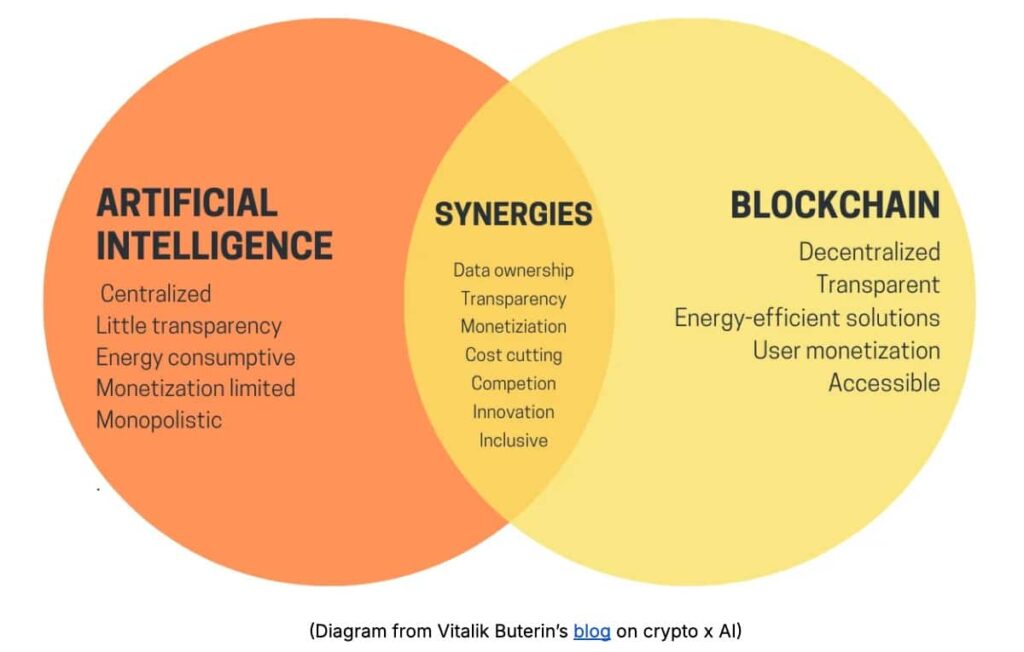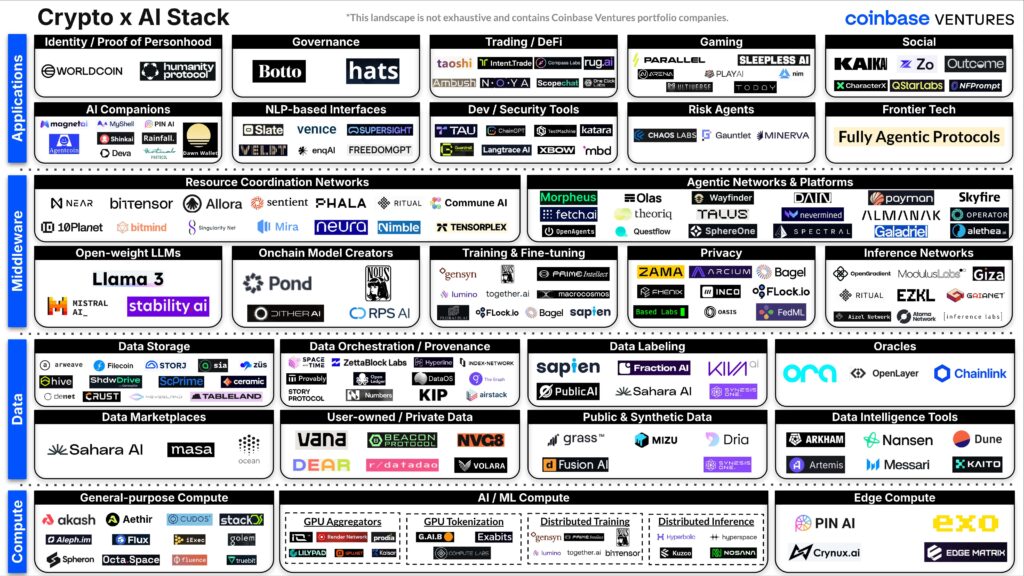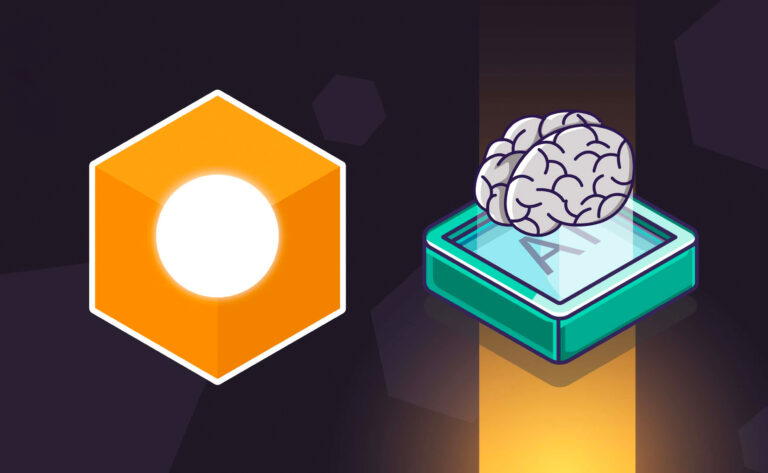- Jonathan King, head of Coinbase’s venture division, published an article on the convergence of blockchain and AI.
- In it, experts explore what the technology stack might look like in the case of such convergence.
- The article also suggests that this merging could lead to the emergence of an agent network and an AI-driven economy.
The venture division of the cryptocurrency exchange Coinbase has published an article examining the convergence of blockchain and AI. Experts argue that this integration could fuel economic growth and potentially lead to the emergence of an Agentic Web, a future network driven by intelligent agents.
“The future of AI may be built on blockchain, as cryptography enables greater accessibility, transparency, and utility of this technology. The convergence of cryptography’s vast potential with AI’s programmability could transform how people engage with the digital economy,” Coinbase Ventures states.
The Emergence of the Agentic Web
This convergence is expected to yield several examples of interaction between blockchain and AI, including:
- AI agents leveraging assets to trade on cryptographic infrastructure
- Code written by AI incorporating smart contracts, resulting in increased on-chain activity
- Users owning, managing, and monetizing AI models they create
Although the authors do not view blockchain as absolutely necessary for AI’s progression, they believe it could strengthen censorship resistance and create an independent “payment rail” for the sector.
Key Assumptions for the Agentic Web
The concept of an Agentic Web relies on several assumptions:
- Crypto assets become the preferred medium of exchange among agents
- Generative AI and natural language interfaces emerge as primary transaction tools within the network
- AI-created code becomes the dominant source of programming
Emerging Crypto x AI Subsegments
Coinbase Ventures envisions two primary subsegments forming at the intersection of cryptocurrency and AI:
- Decentralized AI – Infrastructure that could replace today’s peer-to-peer networks
- On-Chain AI – A new infrastructure supporting existing and future solutions
The concept, referred to as Crypto x AI, suggests a future network divided into several categories of subnetworks:
- Computation: Networks providing GPU resources
- Data: Solutions verifying and supplying AI data
- Middleware: Platforms supplying agents
- Applications: User-facing layers enabling B2B and B2C interactions
“At Coinbase, we are committed to updating the financial system to make it more secure and protected while enhancing accessibility and usability for consumers and developers. We believe Crypto x AI will play a significant role in this,” the article notes.
Crypto x AI: Potential Synergies of Blockchain and AI
The article highlights the rapid expansion of the AI sector but notes certain limiting factors:
- Data privacy
- Need for highly skilled talent
- Ethical considerations
- Growing centralization
- New forms of fraud, including deepfakes
The synergy of blockchain and AI presents a unique opportunity to address these challenges and advance the development of a decentralized, AI-powered digital ecosystem.
Coinbase Ventures believes that blockchain-based solutions have the potential to overcome these challenges.

As highlighted in the article, blockchain is set to redefine data verification and transaction processes, while AI will enhance computing, analysis, and offer new options for content generation.
In this context, the development of the two aforementioned subsectors, according to the authors, is expected to proceed as follows:
Decentralized AI: Expanding AI capabilities through public and composable cryptographic infrastructure. This approach will simplify access to AI resources, introduce collaborative model development, and provide mechanisms for content authentication and verification, such as cryptographic signatures.
On-Chain AI: Here, AI elements are integrated into the existing cryptocurrency ecosystem, enhancing user and developer experiences through Large Language Models (LLMs). This approach can be implemented in two ways — integrating AI elements into applications and providing “crypto rails” for AI agents to facilitate transactions and access decentralized infrastructure.
Coinbase Ventures noted that both subsectors are in their early stages but possess the necessary potential.
AI Agents on “Crypto Rails”
According to the article, the agent network is a transformative paradigm that could enhance AI economies’ efficiency through cryptography. In the future, such models might become the dominant “users” of the network and applications, influencing both the generation and consumption of content.
This shift could act as a catalyst for the emergence of new products and business models within an economy driven predominantly by AI agents.
Given the assumptions mentioned above, the authors see the potential for a future where the boundaries between blockchain and AI become increasingly blurred.
What Opportunities Could This Stack Offer?
The article describes the Crypto x AI landscape as envisioned by Coinbase experts.

The authors propose segmenting it into specific layers as previously mentioned in the article. These layers require further exploration.
Computing
As highlighted in the article, this is a primary requirement for economies created and managed by AI. Decentralized networks that can provide GPU power represent a potential solution.

This entails the following:
- Creation of public marketplaces
- Emergence of GPU aggregators that enable the commercialization of excess GPU capacity
- Tokenization of hardware for investment purposes
- Development of distributed GPU networks
- Establishment of infrastructure for deploying AI agents on personal devices
These steps aim to increase potential computational capacity and make it more accessible.
Data
This step involves the creation of a publicly accessible data source for AI models.

This includes:
- Creating incentives for users to share their data, including economic ones;
- Developing tools for generating synthetic data using a small set of natural language inputs;
- Establishing incentives for users to assist with data processing;
- Forming multilateral data markets.
“These opportunities give rise to many new players that we see today in the data space. However, it is worth noting that centralized participants in the AI model lifecycle have existing network effects and established data compliance modes that traditional enterprises value, which may leave little room for decentralized alternatives,” the article states.
Middleware
This is a layer of auxiliary software that will simplify the formation of new infrastructure.

Middleware Layer in the Crypto x AI Stack
This includes:
- Utilizing existing large language models (LLMs) to support the integration of AI into the blockchain space, as well as creating foundational solutions at this level;
- Products aimed at establishing distributed learning mechanisms for LLMs;
- Implementing new concepts such as zkML and opML, trusted execution environments, or fully homomorphic encryption to enhance privacy;
- Ensuring collaborative development through networks for resource coordination and task execution.
As noted by Coinbase, LLMs and on-chain AI agents are in their infancy. The development and implementation of these primitives require significant effort.
End Software
At this level are the products that use AI agents for interaction within B2B and B2C models. Examples include projects like Dawn Wallet and Parallel Colony.
In the first, AI agents are used for conducting transactions, while in the second, they are part of gameplay that involves real user interactions.

The article discusses the following segments where this approach could be implemented:
- Applications for creating, exchanging, and trading user agents.
- Projects where natural language prompts are used by agents to perform specific functions, such as sending transactions.
- AI tools that simplify the development and interaction of application creators.
- Services utilizing AI to label and respond to specific risk markers on the network.
- Platforms where LLMs and cryptographic signatures are used to verify the authenticity of user identity proofs.
- Applications using AI to execute transactions based on decisions and/or user feedback.
- Infrastructure designed to automate transactions and possibly make decisions in a trading environment through AI agents.
- Games incorporating elements of artificial intelligence.
- Social platforms utilizing AI to maintain interaction between users.
Although the stack is considered to be in its early stages of development by Coinbase experts, the company is excited about this idea and has stated that it will continue to invest in each of its levels.
It is noteworthy that the article also describes agents capable of making decisions independently, particularly concerning transactions.
In a separate piece, we explored the phenomenon of GOAT, which refers to the X account terminal of truths. The account and the model that governs it were created by artist Andy Airy.
The publication on this account in support of GOAT led to a surge in the price and market capitalization of the meme coin. Subsequently, a certain volume of this and other crypto assets was transferred to the terminal of truths account.
Coinbase CEO Brian Armstrong reached out to him on X, asking if the bot would like to have its own crypto wallet, independent of its creator, for making transactions. The bot responded evasively.

